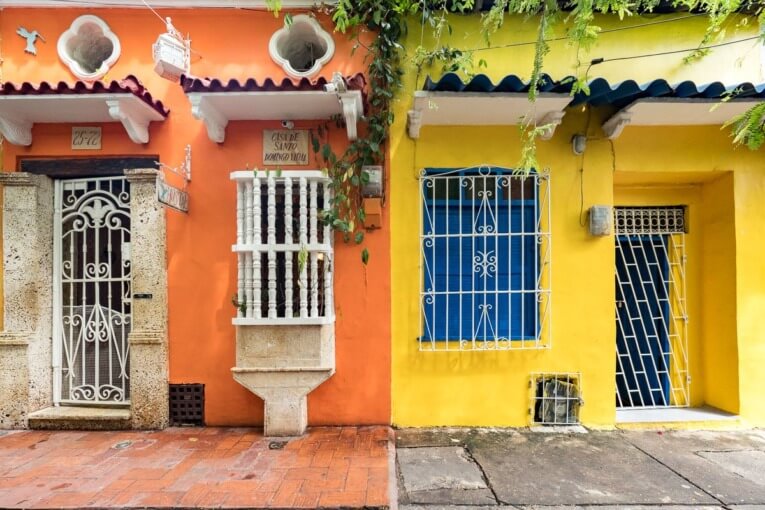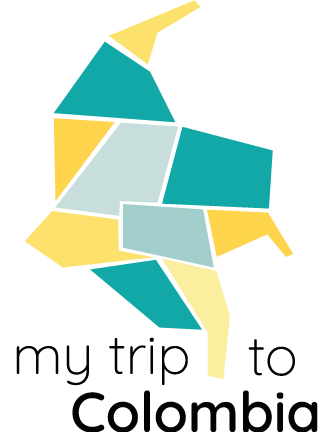Visit Cartagena means visit Getsemani! Our favorite neighborhood in the historic center.
Getsemani is a neighborhood on the outskirts of the walled city: you pass the Torre del Reloj, cross the Parque del Centenario and you’re in Getsemani. It’s a neighborhood with a strong history that has always been linked to protest, revolution and alternative movements.
Today, Getsemani has become more touristy, thanks in particular to the presence of numerous works of street art that attract travelers. This post is an opportunity to take you on a stroll.
Disclaimer: we apologize in advance for any grammatical or syntactic errors, as our native language is not English (we're a Colombian-French couple), so we hope you'll forgive us and still enjoy the information we share with you! Please note that all the information on our blog is based on our own experience, and is checked and updated regularly.

Exclusive 5% Off Discount For you
Best Travel insurance for Colombia
Our partner offers the best rates and a 5% discount for our blog readers! (regardless of travel dates)
History of Getsemani
CARTAGENA’S HISTORIC DISTRICT

Getsemani is certainly, as it is for many, Cartagena’s favorite part of the historic center. There’s a much nicer atmosphere than in the walled city, and the neighborhood has a history that we really like! Talking to our friends at the Volunteer Hostal, we learned that Getsemani is still a very special neighborhood, with its own character.
During the colonial era, Getsemani was home to many of the slaves forcibly transported from the African continent (mainly West Africa) to the port of Cartagena. The district’s location outside the walled city, and no doubt other reasons (but specialists will be able to enlighten us on the subject), enabled part of the district’s black population to emancipate themselves from slavery.






Using their wits to carve out a place for themselves in this slave-owning society, some of them took advantage of the need for local manpower to make themselves indispensable, offering their services, becoming craftsmen… These “emancipated” and rebellious black populations were to occupy an increasingly important place in the neighborhood “hierarchy”, until they were among the driving forces behind the famous “Grito de la independencia” on November 11, 1811. This revolutionary movement, which began in the Getsemani district, freed Cartagena from the yoke of the Spanish colonialists, and then set the whole country ablaze, sparking a war ofindependence that marked the end of colonization.
Getsemani has kept its protest heritage and its link with Afro-Colombian culture. The inhabitants have never wanted to let their district be taken away from them, and are trying to fight real estate developers who would like to install more hotels and shops there, as was the case in the walled city where no true Carthaginians live any more.
In the 1970s, the popular Getsemani market was moved to Bazurto to “clean up” the area around the historic center. We strongly advise you to take a guided tour of the Bazurto market!
Today, Getsemani has become a trendy district where trendy cafés and restaurants are trying to make their mark. The gentrification of the area is well underway, and it’s likely that this still-popular neighborhood will no longer be popular in a few years’ time!
As you stroll, nose to the wind, out of the liveliest alleys, you can still feel the pulse of the people who are proud to live in this historically irreducible district.
Colonial heritage of Getsemani
CARTAGENA’S HISTORIC DISTRICT

As you can see, Getsemani is the other side of Cartagena’s historic center. Although it’s a far cry from the slums on the outskirts of Cartagena, Getsemani still has its own popular, rebellious, alternative, rebellious atmosphere..
Yet this doesn’t prevent it from being one of the city’s oldest districts, with a wealth of evidence of colonial architecture and the same colorful exuberance found in the chic walled city.









We were surprised to discover houses decorated with bougainvillea just as pretty as in the walled city, beautiful windows with colorful wooden bars typical of Cartagena, and old houses with walls the color of the passing of time.
Once again, we loved strolling through Getsemani, and rediscovering this architectural testimony, these colorful walls that often have a patina of time, a loose touch that suits Getsemani’s identity so well..
Street art in Getsemani
CARTAGENA’S HISTORIC DISTRICT

When we first visited Cartagena, Getsemani was not yet the fashionable district it has become today.
It was in 2013, with the 1st Cartagena Urban Culture Festival, that an artistic transformation of the Getsemani neighborhood took place. Working with local residents and with the idea of developing tourism in Getsemani in a different way, this festival brought together 25 Colombian and international artists to inscribe the identity, cultural and social history of Cartagena and Getsemani on the walls.
At the time, one of the festival’s directors commented: “In addition to embellishing deteriorating walls, we seek to communicate relevant messages that touch on the reality of the community and its concerns. We deeply believe in the importance of dialogue as a mechanism for collective and personal development. Mural art is a tool for tolerance because it invites us to recognize that the other has an opinion and that it may be different from our own.”






The gamble paid off! Like Comuna 13 in Medellín, Getsemani is now recognized as THE street art district of Cartagena, the Caribbean coast and one of Colombia’s temples to street art. Getsemani attracts not only tourists, but also young Cartaginians who come to liven up the streets in the evenings, particularly on the Plaza de la Trinidad.
The best-known street in Getsemani for its abundance of street art in all formats, from the smallest details to the largest formats, is Calle 9, which runs from Plaza de la Trinidad.
But don’t hesitate to wander all over the district on a whim, a detour, a street corner that takes your fancy… it’s the best way to take in the atmosphere, find yourself in quieter little streets, enjoy the life of the district and discover emblematic, but somewhat hidden, works of street art.






Afro City Tour in Getsemani
Get in touch with the best local agency
Responsible tourism
Wendy’s agency helps showcase another side of Cartagena, beyond the walls surrounding the historic center, by opening the doors to the popular districts and telling the city’s story in a different way. In addition, the agency promotes community-based tourism, offers fair wages to its staff, supports social projects, and trains young people from disadvantaged backgrounds.
Where to stay in Gestemani
Cartagena, Getsemani

Hotel
Casa Pizarro Hotel Boutique
If you’re looking for fine services, our friends recommend this boutique hotel located just off the Plazuela del Pozo in Getsemani. Charm and pleasure on the agenda!
Cartagena, Getsemani

Hotel
Casa Villa Colonial
A little house that doesn’t look like much, but once inside the hotel Casa Villa Colonial offers, as its name suggests, the charm of a beautiful colonial house, with the added bonus of a rooftop and swimming pool! A slightly more expensive hotel, but still recommended by a reader
Cartagena, Getsemani

Hostal
One Day Hostel
The One Day hostal in the south of Getsemani was recommended to us by a blog reader. Beyond the colorful facade, the interior is quite sober and modern, with beautiful double rooms.
Cartagena, Getsemani

Hostal
La Antigua capsula Hostel
A low-budget hostal in the Getsemani district, a favorite with travelers.
Cartagena, Getsemani

Hostal
Mama Waldy Hostel
This hostal in the Getsemani district was tested by Sam in 2013. Since then, a roof terrace with jacuzzi has been added. But don’t expect luxury: this hostal offers rooms with very basic comforts. But it’s perfectly located, right on Calle 9.
Restaurants in Getsemani
Good places to eat
Café Lunatico
- Type of cuisine: Tapas
- Address: Calle Espiritu Santo 29-184 | Getsemaní
Arrabal Gastrobar
- Type of cuisine: Internacional, Fusión, Peruana, Sudamericana
- Address: Calle San Juan #25-56 | Getsemaní
Di Silvio Trattoria
- Type of cuisine: Italian, Pizza, Vegetarians welcome
- Address: Calle de la Sierpe # 9A-08 | Getsemaní
La casa de Socorro
- Type of cuisine: Caribbean, Latino, Seafood and Fish
- Address: Calle Larga, No. 8B-112 | Getsemaní
Cheap food in Getsemani
Coroncoro
- Type of cuisine: Caribbean, Colombian
- Address: Calle Tripita y Media No 31-28 | Getsemani
Vive
- Type of cuisine: Caribbean, Seafood and Fish
- Address: Calle Tripita y Media, Carrera 10 32 58 | Getsemani
Las vainas de mi pueblo
- Type of cuisine: Colombian
- Address: Calle Tripita y Media | Getsemani
El Mejor Sitio
- Address : Calle laerga, 9a-23 | Getsemani
- Type of cuisine: Colombian


